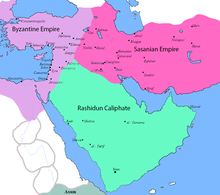Islamic Conquest of Persia
The Muslim conquest of Persia, also known as the Arab conquest of Iran, led to the end of the Sasanian Empire in 651 and the eventual decline of the Zoroastrian religion in Iran.
The rise of Muslims coincided with a significant political, social, economic and military weakness in Persia. Once a major world power, the Sasanian Empire had exhausted its human and material resources after decades of warfare against the Byzantine Empire. The internal political situation quickly deteriorated after the execution of King Khosrau II on February 28, 628. Subsequently, ten new claimants were enthroned within the next four years, highlighting the political instability of the Sassanians prior to the Muslim invasion.
Arab Muslims first attacked the Sassanid territory in 633, when general Khalid ibn Walid invaded Mesopotamia (Sassanid province of Asōristān; what is now Iraq), which was the political and economic center of the Sassanid state. Following the transfer of Khalid to the Byzantine front in the Levant, the Muslims eventually lost their holdings to Sassanian counterattacks. The second invasion began in 636 under Saad ibn Abi Waqqas, when a key victory at the Battle of Qadisiyyah led to the permanent end of Sasanian control west of Iran. The Zagros mountains then became a natural barrier and border between the Rashidun Caliphate and the Sassanid Empire. Due to continuous raids by Persians into the area, Caliph Umar ordered a full invasion of the Sasanian empire in 642, which led to the complete conquest of the Sasanians around 651. Directing from Medina, more than a thousand miles from the battlefields of Iran, Caliph Umar's quick conquest of Iran in a series of well-coordinated, multi-pronged attacks became his greatest triumph, contributing to his reputation as a great military and political strategist.
...
Wikipedia

